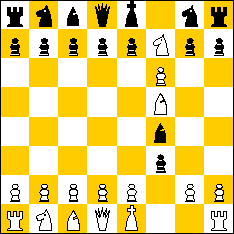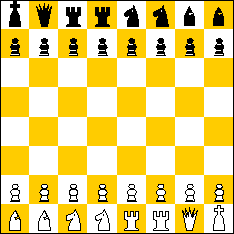Full Belt Chess
Full Belt Chess is a chess variant, invented by Michael Howe of Middletown, Connecticut, USA. This game probably was invented in the 1990's. The information here is from Variant Chess, issue 23, spring 1997, where Peter Wood describes the game, based on a description in Eteroscacco. Peter Wood's text is titled: Not for the Faint-Hearted, which describes the complexity of the variant quite well; games can easily end quite quickly with a mate!
Rules
The rules of orthodox chess are followed, but with the following changes.
- Each row and each column is considered to be a conveyor belt.
- A belt move must always contain at least one piece, and must be made such that the position changes. For instance, after 1. Ng1-f3, white may not rotate the 2nd, 4th, 5th, 6th, of 7th row.
- The first part of a turn is a legal normal chess move: this also means that a player may not stay in check after this chess move.
- A player may not move the same belt as his opponent moved in his previous move.
- Castling and en-passant capture do not exist.
- A pawn promotes only if it is moved to the 8th row by a normal move. When a pawn is moved to the 8th row by a belt move, it stays there and cannot move until it is moved away from the 8th row by a belt move.
- White may not give check in his first move.
After making a move, that is legal under the normal rules of chess,
the player must made a belt move. A belt move means that the player
takes one row or column (belt) and moves this belt any number of squares
in one direction, where the edges of the belt are considered to be connected.
For instance, white could start with 1. Ng1-f3, and then rotate the f-column
four squares; thus, the knight ends up on f7; whites pawn from f2 goes
to f6, and blacks bishop on f8 goes to f4:
 White:
White:
King h1; Queen d1; Rook a1,h1; Knight b1, f7; Bishop c1, f5; Pawn a2, b2,
c2, d2, e2, f6, g2, h2.
Black:
King e8; Queen d8; Rook a8, h8; Knight b8, g8; Bishop c8, f4; Pawn a7,
b7, c7, d7, e7, f3, g7, h7.
There are two optional rules:
- One may not give check with a belt move.
- Start with the following setup, instead of the standard one.
 White:
White:
King h1; Queen g1; Rook f1, e1; Knight d1, c1; Bishop b1, a1; Pawn a2,
b2, c2, d2, e2, f2, g2, h2.
Black:
King a8; Queen b8; Rook c8, d8; Knight e8, f8; Bishop g8, h8; Pawn a7,
b7, c7, d7, e7, f7, g7, h7.
Written by: Hans Bodlaender
WWW page created: March 24, 1997.
